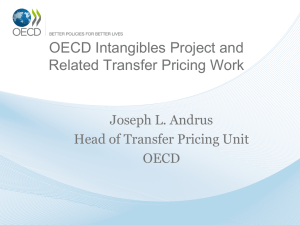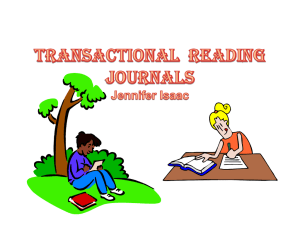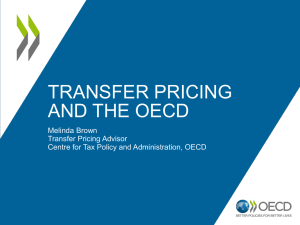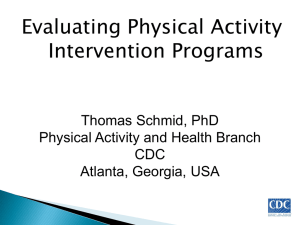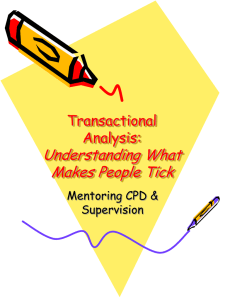Lecture_8_TP
advertisement
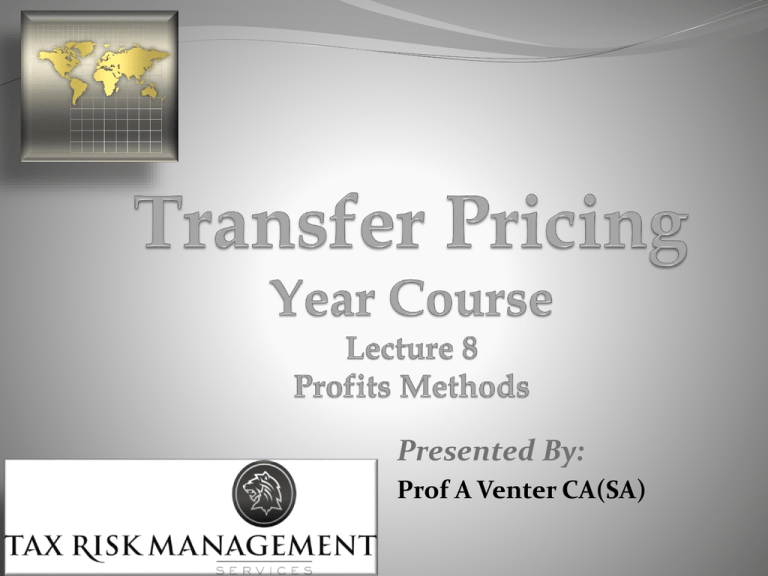
Presented By: Prof A Venter CA(SA) Selection of TP Methods: Part II SESSION INCLUDES: TRANSACTIONAL PROFITS METHODS Transactional Net Margin Method (TNMM) Transactional Profit Split Method Selection of TP Methods TRANSACTIONAL PROFIT METHODS Transactional Net Margin Method (TNMM): Examination of a net profit indicator: ratio of net profit relative to an appropriate base (costs, sales or assets) of controlled transactions with those of uncontrolled transactions. Internal or external comparable transactions: based on functional comparability (not product specifically) Weighted costs or sales, similar to “Cost plus method” and “Resale Price Method” respectively: except Net profit is compared, not gross profit/mark-up. Most often indicator used: Operating profit (before interest, tax and extraordinary items) Selection of TP Methods TRANSACTIONAL PROFIT METHODS Transactional Net Margin Method (TNMM): Profit indicator uses: Against costs: manufacturing and service activities Against sales: sales activities Against: assets: asset-intensive activities Financial indicator should: Reflect the value of functions performed (assets and risks) Based on objective data Capable of being measured reliably and consistently at level of both controlled and uncontrolled transactions Example 1 Product X Independent Party Product Y Parent Co CoA Sales: 50% Product X 50% Product Y Example 1 Example 2 DDI DDI US DDI CANADA Clients Example 2 Asset Value $10 000 000 ROA (Canada): 10% Profit: $1 ooo 000 $1 m/ 500 000 units = $2 profit per unit Cost: $10 per unit Price: $2 per unit Example 3 UK Parent Good Food Independent Retailers Example 3 TP Methods TRANSACTIONAL PROFIT METHODS Transactional Net Margin Method (TNMM): Illustration 1: difference between Resale Price and TNMM for distributor. Description Sales to independent customers Cost of goods (from associated enterprises) Gross Profit (60%) (Tested in resale Price Method) Selling and other operating expenses Amount 1000 (400) 600 (400) Operating Profit (20% of sales) (Tested in a TNMM) 200 Interest and exceptional items (20) EBT (Earnings before Tax) Income Tax Net profit 180 (60) 120 TP Methods TRANSACTIONAL PROFIT METHODS Transactional Net Margin Method (TNMM): Illustration 2: difference between Cost Plus and TNMM for manufacturer. Description Cost of raw materials Production costs Total cost base Mark –up (20%) (tested in a cost-plus method) Amount 1000 (400) 600 (400) Transfer price 200 Overheads and operating expenditure (20) Operating profit (5% of cost) (tested in a TNMM) 180 ZE(Zambia) ZE (Botswana) GP: 9% SP: $990 Raw product GP: 20% SP: $1286 GP: 20% SP: $1286 ZE (Kenya) ZE(Zim) ZE (Tanzania) Import & local GP: 50% SP: $4000 A1 Swaziland A2 RSA Kenya Agent Tanz Agent Angola GP: 39% SP: $1700 Mozam bique Feinschreiber Transfer Pricing Handbook (1) Transfer Pricing Handbook, 2 Volume Set, editor Robert Feinschreiber (available in Amazon.com Kindle) 11.3 WIDGET WHOLESALE (Kindle Location 2550). Kindle Edition. FM1 FM2 Manufacturing WW FM3 Independent distributors CA Retailers CA Imports widgets from WW WW-US Distribution Other Retailers Feinschreiber Transfer Pricing Handbook (2) 1. Classification: Identify the issue under investigation: income of US taxpayer Payments made to foreign parent for purchased goods will be investigated The question is whether an independent company would be willing to pay the same prices for the goods, as WW-US is paying the foreign parent Business classification: WW-US is a pure importer/distributor Feinschreiber Transfer Pricing Handbook (3) 1. Classification (continued) Import consideration: in order to earn a profit importers need to limit costs and expenses, such as purchase price of goods; shipping and transport, import duties, storage , advertising and selling expenses Import contract: when dealing with independent manufacturer, the importer will deal negotiate contract covering various issues Wholesale Relationship: wholesaler imports large quantities and makes profit from high turnover of products, Usually has a large marketing investment. Feinschreiber Transfer Pricing Handbook (4) 2. Finding Comparables No independent importers of widgets Numerous importers of other durable goods with publicly available information Widgets do not have separate SIC code Wholesale trade category Comparables: distributors of consumer durables with motorised and electronic technology, used in the home (perceived product similarity)* 100 companies over 5 years Feinschreiber Transfer Pricing Handbook (5) 3. Method used WW-USA needs to be adjusted to reflect arm’s length purchase price for goods imported Logic: distributors would not buy at prices it could not sell profitably. Only possible comparable for the transaction : resell of independent California Distributors, adjusted for differences for conditions of sale, models, market level, services provided etc. The Resale Price Method (RPM) can then be used to determine an arm’s lengthy price. CPM: reflects the effectiveness of applying the arm’s length price Feinschreiber Transfer Pricing Handbook (6) 4. PLI’s used Gross profit to operating expenses Operating income on sales Return on operating assets: Feinschreiber Transfer Pricing Handbook (7) 1.7 1.6 1.5 1.4 1.3 Mean less one Mean plus one Mean WW adjusted WW-USA 1.2 1.1 1 0.9 0.8 0.7 Y1 Y2 Y3 Y4 Y5 Feinschreiber Transfer Pricing Handbook (1) Transfer Pricing Handbook, 2 Volume Set, editor Robert Feinschreiber (available in Amazon.com Kindle) 11.2 Location 2409 Integrated functions AP1 CM -US Independent Contractor Cost +15% AP2 Imports ingredients Exports final product to CM-US Royalty 5% Independent wholesalers CM-EU Manufacturing: Modern industrial plant AP1 AP2 Manufacturing functions CM –US Jupiter Drinks Technology for 5% Royalty Contract Manufacturer Cost +15% Imports ingredients From CM-US Distributors CM-Nigeria Fully-fledged manufacturer Independent wholesalers in Nigeria Feinschreiber Transfer Pricing Handbook (1) A summary of the broad guidelines suggested: establish economic justification before the transaction is entered into; be satisfied that the consideration is an arm’s length consideration; prepare and retain contemporaneous documentation to support the above matters and the assessment of market conditions at the time when the pricing decisions were made; justify the choice of method; and establish and consistently follow a systematic process for setting arm’s length international transfer prices. Feinschreiber Transfer Pricing Handbook (2) 1. Classification: Identify the issue under investigation: income of US taxpayer CM-EU income comes under scrutiny: receives intangibles from US taxpayer and had higher profit margins than the Parent CM-EU classified as drug manufacturer (SIC #2833) Feinschreiber Transfer Pricing Handbook (3) 2. Finding Comparables CM-EU: Direct comparables: may possibly be CM-US assembly plants or independent contractor used CMUS Indirect comparables: possibly other large integrated drug companies or smaller contract manufacturers Functions are closer to contract manufacturers, but incurs the costs and risks of operating in a foreign market place. Feinschreiber Transfer Pricing Handbook (4) 2. Finding Comparables: Direct comparables (transaction based) Assembly plants of CM-US: various product lines and integrated functions, difficult to separate one product line for comparison. Independent contractor: differences: Patent rights: reduce COS with royalty payment Market risks: no contract guarantee, foreign market: difficult to quantify Advanced physical facilities: difficult to identify which operating expenses to add back Feinschreiber Transfer Pricing Handbook (5) 2. Finding Comparables: Indirect comparables (profit based)(public data needed) Integrated drug companies: owns intangibles and incurs risks like these companies, but do not have integrated functions Independent contract manufacturers: independent manufacturing, but not guaranteed by contract and owns intangibles. Feinschreiber Transfer Pricing Handbook (6) 3. Method used CPM: more than one type of transaction, with no direct comparables as to similar transactions Intangibles transferred with effect on profitability Profit methods reflects reasonableness Transaction method used to ascertain appropriate royalty rate Feinschreiber Transfer Pricing Handbook (7) 4. Arm’s length range Profit Level Indicator (PLI) range: high-end of large companies’ PLI’s and low end on contract manufacturer’s PLI’s. Adjust royalty rate to an arm’s length rate, by doing market research, scrutinizing third party contracts and independent transaction. This indicated that a proper rate should increased to 25% Feinschreiber Transfer Pricing Handbook (8) 5. PLI’s used Gross profit to operating expenses Operating income on sales Return on operating assets: good indicator for manufacturers, but assets may vary quite extensively. Good PLI for CM-EU which owns intangibles and state of the art plant and equipment with one product for allocation purposes. Not so good for parent with various product lines, and previous investment in assets. Feinschreiber Transfer Pricing Handbook (9) 40% 35% 30% 25% Contr Man CM-EU 20% CM-US 15% Drug Co's 10% 5% 0% Mean Maximum Minimum TP Methods TRANSACTIONAL PROFIT METHODS Transactional Profit Split Method: Starting point: identifies combined profits to be split between associated enterprises. Some cases: total profits from controlled transactions Other cases: residual profit that cannot be readily assigned to a specific party, from the application of other TP methods, such as profits from intangibles (may even be a loss). Division of anticipated profits on economically valid basis TP Methods TRANSACTIONAL PROFIT METHODS Transactional Profit Split Method: Economically valid basis: may be supported by independent market data (division ratios of uncontrolled transactions) may also be (most often) internal data Internal data: depends on the facts an circumstances (sales, R & D expenditure, assets, operating expenses) Splitting factor: should reflect respective contribution of parties to generating of income from controlled transactions Must be based on objective data, rather than remuneration from controlled transactions. TP Methods TRANSACTIONAL PROFIT METHODS Transactional Profit Split Method: Associated Enterprise A Associated Enterprise B Contribution by A to controlled transaction: x% Contribution by B to controlled transaction: y% Controlled Transaction Profit Profit share attributable to A: X% Profit share attributable to b: Y% Description Amount Percentage Currently Percentage Cost contributed to ZE Zambia 1 028 82,18% Cost contributed to ZE Botswana 223 17,82% Total costs 1 251 100% Total Profit 2 248 100% 2 248 100% Profit allocated to ZE Z 1 848 82,18% 257 11,44% Profit allocated to ZE B 401 17,82% 1 991 88,56% New GP% on transaction for ZEB 11.44% Price to ZEZam 2 876 New GP% on transaction for ZEZam based on new price 64.24% Selling Price 57% 20% Selection of TP Methods Selecting the Appropriate Method: Four criteria: Strengths and weaknesses of OECD TP methods Results of functional analysis Availability of reliable information Degree of comparability between controlled and uncontrolled transactions Selection of TP Methods Selecting the Appropriate Method: STRENGTHS AND WEAKNESSES OF OECD TP METHODS CUP: most direct and reliable method high product similarity needed, not always available in practice Resale Price Method: most useful for marketing operations fewer adjustments needed for product differences, functions based Selection of TP Methods Selecting the Appropriate Method: STRENGTHS AND WEAKNESSES OF OECD TP METHODS Cost Plus Method: useful for transfer of semi-finished goods, manufacturing and services functions base: fewer adjustments for product differences Challenges: cost determination and accounting inconsistencies TNMM: Less affected by transactional differences, more tolerable for functional differences (reflected in operating expenses) Selection of TP Methods Selecting the Appropriate Method: STRENGTHS AND WEAKNESSES OF OECD TP METHODS TNMM (…continued): Useful for integrated transactions, or when difficult to obtain info on one of the parties Weaknesses: difficulty establishing comparability (transactional level) Timing of transaction: net profit info usually not yet available (multiple year data may be a solution) Difficulty establishing corresponding adjustment Selection of TP Methods Selecting the Appropriate Method: STRENGTHS AND WEAKNESSES OF OECD TP METHODS Profit Split Method: Solution for highly integrated operations Solution for when unique and valuable contributions are made Not used when one of the parties does not make a significant contribution Comparables data can support split ratio, otherwise internal data can be used Flexibility in unique circumstances and facts Both parties tested: very fair method Weakness: difficulty in application when info of foreign affiliate not readily available. Selection of TP Methods Selecting the Appropriate Method: FUNCTIONAL ANALYSIS Method should be consistent with functions performed by “tested party”: Cost plus method: seller is tested party Resale price method: buyer is tested party TNMM or CUP: either seller or buyer is tested party Profit Split method: both parties are tested Selection of TP Methods Selecting the Appropriate Method: AVAILABLE RELIABLE INFORMATION CUP method when uncontrolled transactions are highly comparables Availability of gross or net profit information will determine whether traditional or profits methods are used. DEGREE OF COMPARABILITY Data with a high level of comparability will be a priority when the appropriate method is selected. Keep in mind that comparables are very rarely perfect or complete: professional judgment will be involved Selection of TP Methods Selecting the Appropriate Method: Don’t have to proof other methods are not suitable Traditional methods preferred over transactional profit methods Where CUP preferred over other methods, if both can be applied equally reliable manner Situations where Profits Methods more appropriate than Traditional methods Profit Methods only accepted it compatible with Article 9: comparability May use “other methods” More than one method may be used, but is not mandatory See Illustration on page 16 OECD document on TP Methods July 2010 Selection of TP Methods Source: OECD Guidelines: Chapter 2 UN TP Manual for Developing Countries: Chapter 5 ATAF: TP for Policy Makers: Session 1: “TP Methods” by OECD (PDF) Transfer Pricing Handbook, 2 Volume Set, editor Robert Feinschreiber (available in Amazon.com Kindle) IBFD TP Database: “Introduction to Transfer Pricing” BNA Transfer Pricing International Journal “CUPs and Profit Splits – when and how to use”
